Twilight, nighttime and low light offer some of the best opportunities to shoot dramatic images. You can photograph such diversity as clouds bathed in a blaze of color just after sunset, a city skyline at dusk, or the dark interior of a historical building. Many photographers purposely seek the light that occurs the first hour of dusk — there's no need to pack up your camera just because the sun has gone down. Whether you're shooting outdoors in the evening or indoors in a low-light situation, chances are that you'll make long exposures. This requires use of a tripod and a cable release to avoid shaking the camera when it's set for several seconds or on a bulb (B) setting. You also want to carefully meter your exposures, as there may be sources of light that appear in the frame that can fool your camera's meter. Bracket your exposures and shoot lots of images.
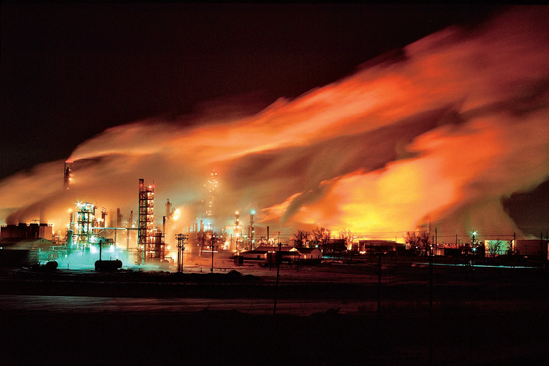
"Red Steam"
© Bert Hustad
Gilbert, Arizona
Although many photographers may pass up an industrial scene in favor of more traditional subjects, these sites often have visual intrigue, especially when photographed at night. Like landscapes or city skylines, most industrial settings have a particular mood that's distinctly their own. Try to find a viewpoint or a special technique that helps capture the site's special atmosphere. For example, this photographer used a long time exposure at night to capture the red steam emitting from these towers, which provides a great contrast to the artificial blue light around the base of the compound. When photographing any industrial location, be sure to observe their rules and safety procedures. Working from a distance ensures your safety.
"I drove by this refinery in Denver, Colorado, on my daily commute and visualized a possible shot. It presented itself on a cold (7 °F and falling) January night on the way home from work. I rushed home and grabbed my camera, returned to the refinery, waded through over two feet of snow for the best angle, and shot a series of timed exposures. I counted out the exposure times through chattering teeth to keep warm — well worth the effort!"
Canon F-1 35mm camera
Canon 50mm f/1.4 lens
Kodak Kodachrome 64 film
Approximately 10 seconds at f/8
Ambient light at night
Sunrise and sunsets can offer dramatic photo opportunities, far more so than if this scene had been shot during the middle of the day. To capture a sunrise scene like this, you must scout out your vantage point ahead of time and be an early riser. This photographer had the additional good fortune to capture a fog-free scene. San Francisco conjures up visions of the Golden Gate Bridge, trolley cars, or the city skyline. But this serene sunrise image renders San Francisco as a beautiful spot by the bay, with the hustle and bustle of the city at the horizon line far beyond.
"There is no other city that I love more than San Francisco. I thought it would be fitting to give people a different perspective of the city and just how beautiful it can be. Every morning that the sky is clear, you maybe treated to a breathtaking sunrise that silhouettes the city and casts it and the bay in different shades of magenta, orange, and blue. This was one of those mornings where all the colors came alive. One of the largest pastimes in the bay area is sailing, so I though it was fitting to photograph the sailboats using San Francisco as its backdrop."
Canon EOS 30D digital SLR
Canon EF 24–105 f/4 L zoo lens set at 24mm
22 seconds (f-stop not recorded)
ISO 100
Morning light at daybreak
"San Francisco at Daybreak"
© Jennifer Sawle
San Francisco, California http://www.bjesf.org
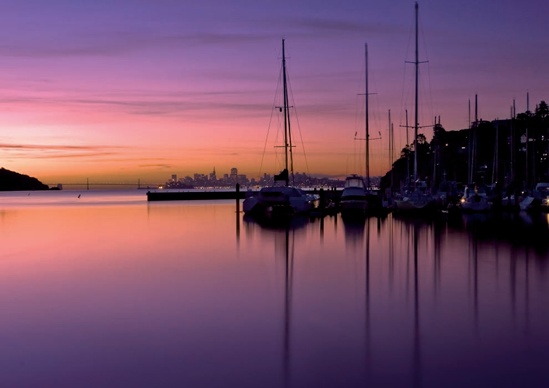
"Eiffel Tower"
© Barry Pruett
Indianapolis, Indiana
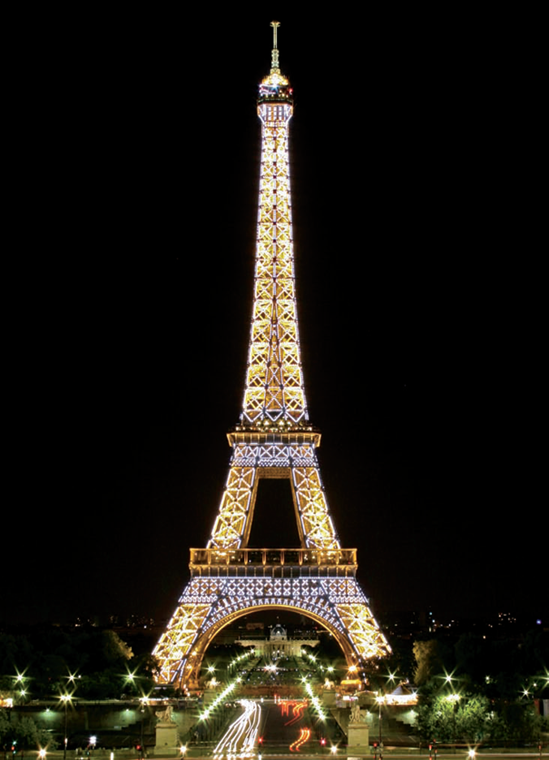
Without a doubt, the Eiffel Tower is the most frequently photographed icon in Paris, and — as with many buildings — even more magical when illuminated at night. Buildings take on the color characteristics of the artificial light source being used. The incandescent sparkling light on this structure gives it a warm, bejeweled look. The streetlights below are rendered as bright stars because the photographer used a small aperture, and a long time exposure allowed the street traffic to be recorded as streaks of red and white. The long time exposures that nighttime photography requires also necessitate use of a tripod.
"This was the first time I had been to Paris, and I found myself taking numerous shots of the Eiffel Tower at different angles and from locations around the city. After just a few days, I decided that, in my opinion, the best time to see the Eiffel Tower is at night, when it has the various lights illuminating the steel structure. If you've been to Paris, you know that at night on the hour the Tower has hundreds of strobe lights flashing to make it sparkle. I wanted to capture that image. Just before midnight, I set up my tripod and waited for the moment the strobes started to sparkle. In the finished image, the Tower looks like a piece of jewelry — or as my kids say, the Eiffel with some 'bling.'"
Canon EOS 30D digital SLR
Canon EF 28–135mm f/3.5–5.6 IS zoom lens
20 seconds at f/14
ISO 100
Tripod
Ambient night, city light
There are several ways to photograph a fireworks display. For handheld shots, try using a fast ISO (400 or greater), aim your lens in the direction of the fireworks, wait for the peak of a burst, and shoot. An exposure of 1/60 of a second at f/2.8 is a good exposure to start with when shooting bright, nearby displays. To encompass several bursts of light, set your camera on a tripod, set your camera on "B" and the aperture on f/8, and capture a series of bursts on one frame. Photos of fireworks are always more dramatic when you include foreground interest, as the photographer did here. The fireworks, Mount Rushmore, and the American flag add up to a strong patriotic statement.
"I love fireworks, especially to celebrate Independence Day. The challenge was to create an image that captured the essence of the holiday, combining Mount Rushmore, the fireworks, and the American flag. Patience is a virtue when working with low light in a crowd of enthusiastic onlookers. My patience paid off at the last light of sunset."
Canon EOS 20D digital SLR
Canon EF 75–300 f/4–5.6 IS zoo lens set at 30mm
2 seconds at f/4.5, Shutter Priority mode
ISO 100
Manfrotto 724B Digi tripod
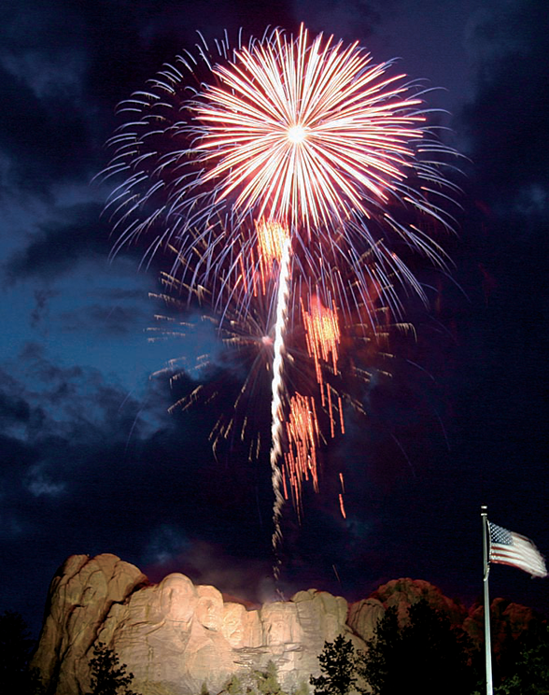
"Fireworks at Mount Rushmore"
© Matt Guasco
Wantagh, New York
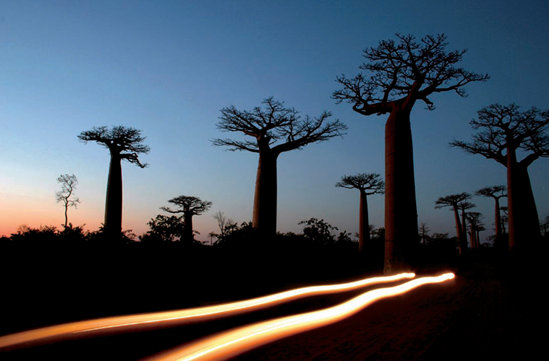
"Magic Baobabs"
© Yann Feron
New York, New York www.yannferon.com
Time exposures enable your camera to record patterns of moving lights that can't be seen by the eye after dark. Automobiles usually move too fast to be recorded on your memory card or film during a long time exposure, but their headlights and or taillights leave a mysterious illuminated streak across the scene. There are no hard and fast rules, but generally you want a long time exposure anywhere from five seconds up to a couple of minutes, along with a small f-stop to avoid overexposure. A tripod is also very important. This image portrays an otherworldly feeling, with the silhouettes of these unusual trees providing the background for the traffic streaks.
"This is a traditional location in Madagascar where tourists shoot sunset photos. I shot some of these, but after the others left, I stayed alone with my camera and tripod (and fought off thousands of mosquitoes). I wanted to capture the last ray of light in the sky after the sun had set. To my eye, everything was dark, but with a long exposure and the right aperture I was able to capture the light that was invisible to the eye. When this taxi came by, I knew I got the perfect shot. Only its lights can be seen and you can't even see the car itself — just magic — and the 'Magic Baobabs,' these great trees in Africa."
Canon EOS Digita Rebel
Canon EF 18mm wide-angle lens
30 seconds at f/18
ISO 200
Ambient light at dusk
The best time to take pictures that include the moon is during the first couple of nights during a full moon. In this photo, the moon and other lights appear star-like because the photographer used a small aperture. The reflection of the light on the water is beautiful, and provides contrast against the dark hill on the left side of the frame. The illuminated color of the Golden Gate Bridge is also very striking. Be very careful when exposing for an image like this one, where several light sources could potentially fool your meter. Bracket exposures for best results.
"I lived in Sausalito, California at the time I took this photo, so this location was very close to my home. At one of the first parking areas at the Marin Headlands, you can walk about a quarter mile to a great viewpoint of the bridge and the San Francisco coast. I chose a full moonlit night for this shot. I got several very nice images that evening shooting with a variety of cameras and lenses, and I was lucky enough to get several printable images. I especially liked the reflections of the moon and bridge in the water, and the 'golden' color of the bridge in the moonlight. I have this image framed in my home office, and it certainly reminds me that I left part of my heart in the City by the Bay."
Canon Powershot G2 compact digital SLR
Tripod mounted
10 seconds at f/8
"Golden Gate Moonlight"
© Ken Cohen
Anthem, Arizona
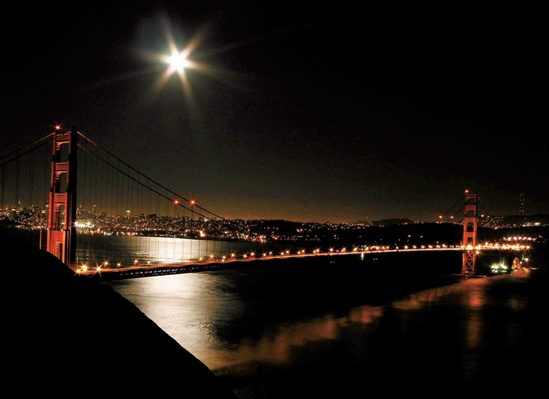
Sunset is one of nature's great spectacles, and always lends a sense of drama to a photograph. By experimenting with a variety of exposure settings, you can determine what works best for a particular scene. Whatever you do, however, take your meter reading from a portion of the sky away from the sun. This deepens the colors in the sky, as well as in the foreground. Because the sun is an extremely bright light source, it causes your meter to respond inaccurately when you take your meter reading directly from the sun. This image is also successful because of the detail in the grass in the foreground.
"We were in Cape Cod for the weekend, and the wind and rain were fierce. This was in November, and a lot of the summer homes at the Cape are vacated at this time of year. We took shelter on someone's porch to check out the waves crashing onshore. Sand was pelting us from the right, but when we looked to the left, we all paused at how beautiful the sunset was. I snapped a few pictures — sometimes you just get lucky!"
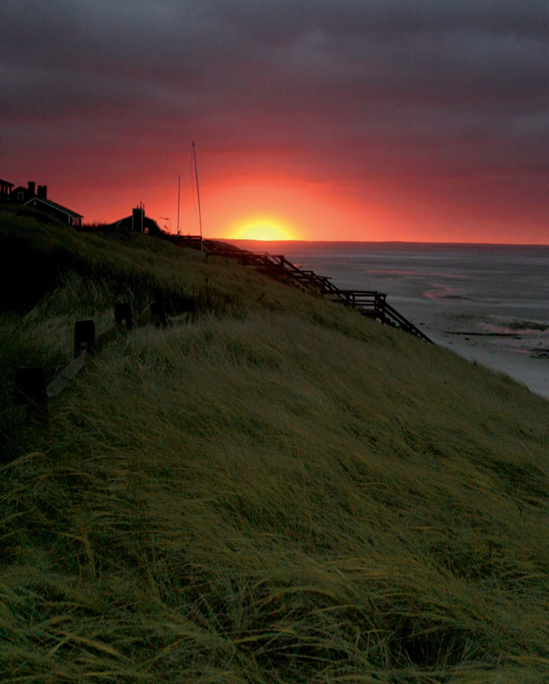
"Cape Cod Sunset"
© Stephen Strutt
Seaford, New York www.struttcreative.com
Canon EOS Digita Rebel
Canon EF 28–135mm IS lens
1/2 of a second at f/3.5
ISO 800
Ambient light at sunset
In photography, one of the most striking ways to reveal a shape is by creating a silhouette. Simply position an opaque object in front of a bright background and expose for the background. Any brightly lit backdrop will do. Look for simple, easily recognizable shapes to render in silhouette, like a sailboat crossing a glittering gold section of the sea, a person in front of a colorful wall, or a couple walking on a beach at sunset. More often than not, you have to orchestrate this setting; rarely does an interesting subject and bright background just happen to coincide. Experiment with a variety of exposures, as several of them can produce good silhouettes. And if you're shooting a silhouette against a sunset, consider using a sunset or enhancing filter to make the sky even more brilliant.
"This image was shot at Saguaro National Park outside Tucson, Arizona, in early spring. It was evening in the desert. My wife and I were driving through the park and just watched a large, diamond-back rattlesnake slink across the road and down a cliff into the rocks. She was reluctant to get out of the car while I took this picture. There are many cacti inside the park, and evening is my favorite time to photograph them. Many bloom at night and their flowers are often gone by morning. This old saguaro was particularly dramatized by the evening sunset."
Canon EOS 5D digital SLR
Canon EF 70–200 zoo lens set at 90mm
f/32
ISO 200
Evening light
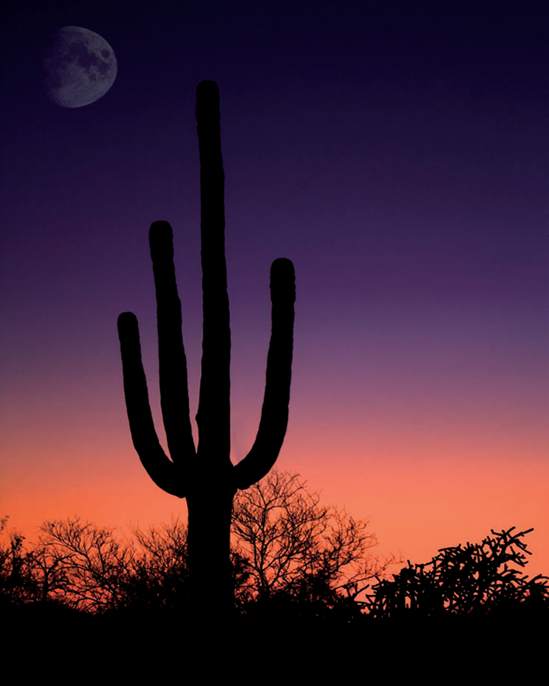
"Saguaro Night"
© Keith Livingston
Longmont, Colorado

"Morning Mist"
© Andrew Harris
Pensacola, Florida http://www.photo.net/photos/lefthook51
The best place to find misty, ethereal conditions like this one is on or near bodies of water. And the best time of day to photograph it is near dawn, before the sun has had a chance to burn off the night's accumulation of mist. This moody, almost monochromatic image is a good example of atmospheric perspective — a feeling of distance that you see when haze is in the air, which makes objects look fainter in tone as they recede.
"I work on a drilling barge on the marshes in Louisiana, and waited two months to shoot this scene because it was either too foggy or too bright. I really feel that this shot captures a winter mood. I took it from the helideck of the barge."
Nikon D2X digital SLR
Nikkor 120mm lens
1/40 of a second at f/6.3
ISO 200
Ambient light on a foggy morning
The city comes alive at night, giving you opportunities to capture some striking photos of cityscapes illuminated against the sky. Some buildings (particularly those of cities like Las Vegas) are illuminated brightly enough so that you can even shoot without a tripod. But for the most part, you are better off using one to ensure sharp images during long exposure times. You'll get even better results when you take pictures in the early evening, up to an hour after sunset, when the lingering light of dusk adds a little color to the sky, as opposed to shooting pictures of a brightly lit city when the sky is completely dark.
"Holiday season at Grand Central Terminal in Manhattan is a special time, it seems. A multi-media 'lightshow' was being projected throughout the recently refurbished station — it stopped me dead in my tracks, and I frantically searched for a level surface to mount my little mini tripod. Grand Central always seems to have a distinct vibe, and somehow the space swallows a great deal of noise and lends an almost respectful hush despite the hubbub. This occasion was no exception; the only difference was that more people stopped to look and listen to the show. At the risk of 'gilding the lily,' I think they did a fine job of adding magic to an already awe-inspiring public venue."
Canon EOS Digita Rebel
Canon EF 18–55 zoo lens set at 18mm
1/4 of a second at f/3.5
ISO 200
Ambient light at night
"Grand Light Show"
© Jim Lynch
Mount Sinai, New York www.jimlynchphotography.com
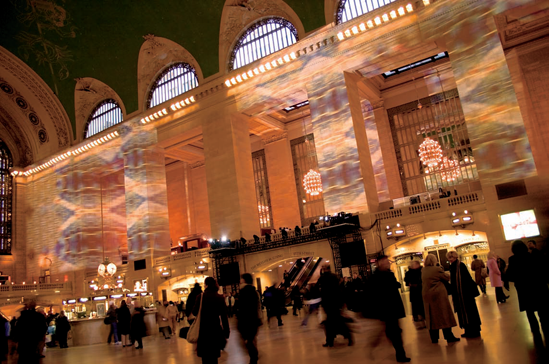
By adding a pier and some seagulls to the mix, this image of a pastel pink sunset scene is very intriguing. Sunsets and the magic hour are beautiful enough, but including a simple foreground element adds a center of interest and reveals something of your location. Much of the pier in this photograph is in silhouette, and the glimmering arcade lights add a festive feeling. One of the most challenging parts of photographing a scene like this is finding a good vantage point before it gets too dark.
"I was taking a Photoshop class at Santa Monica College in December. When I left class around 4:30 p.m., the sun was starting to set, creating a potentially gorgeous sunset. I rushed to the beach at the Santa Monica Pier, which is only a five-minute drive from the college. I parked and ran across the sand with my camera and tripod. The tide was low and the sun was reflecting the clouds onto the wet sand. I couldn't believe how pink this sunset was. It was one of the most beautiful sunsets that I had seen in several years. Having the seagulls and arcade lights was an added bonus. I found the right point of view and set up my equipment. I had enough time to capture several images, but this one was my favorite."
Canon 1Ds Mark II digital SLR
Canon EF 100mm f/2 lens
1/2 second at f/5.6
Manual exposure setting
ISO 100
Bogen tripod
Natural light at sunset
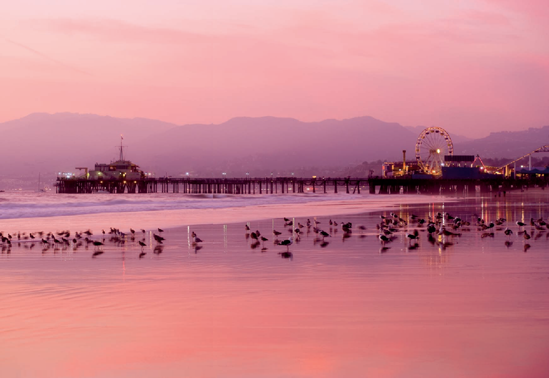
"Santa Monica Pier in Pink"
© Jim McKinniss
Redondo Beach, California http://jim_mckinniss.photoworkshop.com

"Touch the Sun"
© Brian K. Morrow
Porterville, California www.allamericanimages.com
It's a good idea to use a telephoto lens when you want to include the setting sun in your images. This way, the sun will be rendered as a large orb. But when you meter your image, take your reading from a portion of the sky away from the sun, as the sun is a very bright object that will fool your camera's meter into underexposure. Bracket your exposures from one stop over to one stop under your camera's through-the-lens metering recommendations—you may wind up with several acceptable images. Including a simple foreground element adds interest to your sunset photos and may say something about your location. Try to scout out locations ahead of time so that you can silhouette an interesting object against the bright background, as this photographer has done with the needles of a pine tree. As the light becomes increasingly dimmer at sunset, you need to use a tripod or another means of steady camera support.
"The location was Cambria, California, and I took this shot between our beach house and the neighbor's house. I was heading out to shoot some evening photos. As I headed past our mailbox, I looked over my right shoulder, composed this image in my head, and then captured the moment."
Canon EOS Digita Rebel
Canon EF 70–300 zoo lens set at 300mm
1/160 of a second at f/5.6
ISO 100
Natural light at sunset
Tripod and cable release
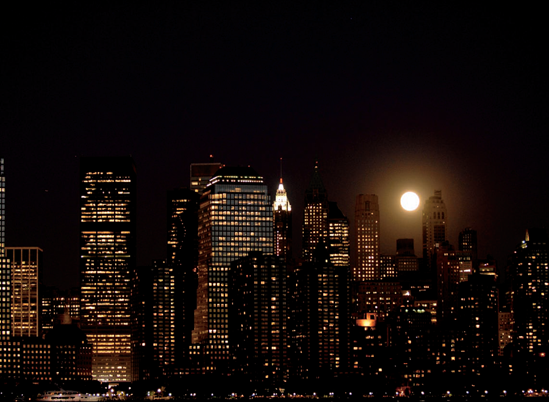
"City by Night"
© Annette Chapman
New York, New York http://annette_chapman.photoworkshop.com
The high-rise buildings of a city nearly always look more elegant from a distance, and photos of a skyline at night can be especially dramatic. All you need is a good spot from which to shoot it. Surrounding hills, bridges, and windows of other high-rise buildings often provide vantage points for expansive city views. A variety of exposures may be acceptable; you can experiment with time exposures ranging from less than a second to a minute. In this image of New York City, the photographer included the moon rising between two of the buildings, which is more interesting than if she had captured the cityscape alone. A tripod is recommended, but if the city lights are bright enough, sometimes a fast ISO in the 400–1600 range will do.
"I have always loved the New York City skyline. I heard that there was going to be a full moon on this night. A friend and I went over to the New Jersey side to try to capture it. I used various exposures and experimented with the hope of getting a good photo. 'City by Night' was the result."
Nikon D200 digital SLR
Nikkor 70–200mm f/2.8 IF VR zoom lens
1/4 of a second at f/2.8
ISO 320
Manual exposure mode
Gitzo tripod with a cable release
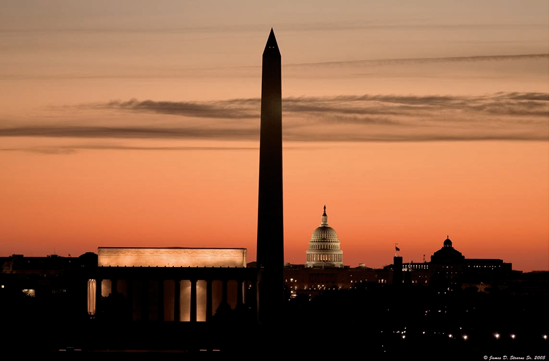
"Monuments"
© Jim Stearns
Woodbridge, Virginia http://jimdstearns.photoworkshop.com
Dusk and dawn are magical times to photograph city skylines Many monuments and statues are lit up when it's dark, giving you the opportunity to utilize these lights to get exciting photographs These lights often record very warm on film and memory cards, but as you can see in this image, the results are very pleasing The variety of lights and silhouettes offers some nice visual diversity The photographer captured the illuminated Lincoln Monument and Capital building, and rendered the Washington Monument as a silhouette against the warm-hued sky, which works well with the warm glow of the illuminated buildings Look for a time at sunrise or dusk when the light in the sky is in balance with the light on the buildings.
"I had just finished shooting the Marine Corp Iwo Jima Memorial, which is on the high ground just outside of Rosslyn and overlooks the Washington D.C. mall area. I started walking back to my car when I looked up and saw this view of the Lincoln and Washington Monuments with the U.S. Capitol in the background. For me, it symbolized the dawn of a new day that democracy works for us all, and I captured this shot."
Canon EOS Digital Rebel
Canon EF 70–200mm f/2.8 L I zoom lens set at 200mm
1/6 of a second at f/2.8
ISO 100
Ambient light at sunrise
One of the biggest challenges when photographing a city skyline is finding the perfect vantage point from which to capture it. Many major cities have observation decks that offer great views, or there are various places at ground level (such as this one across the water) where you can find beautiful, unobstructed city vistas. You'll need to scout out your shooting spot well in advance to avoid scrambling around when light is quickly fading. Twilight is a magical time to shoot cityscapes, as a little light still lingers in the sky and buildings and streetlights glimmer.
"I think one of my favorite activities after a good dinner out is to head down to the coastline along New York City, where you get a perfect view of the prettiest skyline anywhere. I shot this photo on a warm, damp, late-August night. As I carefully set up my tripod on a grassy slope in Long Island City, the mist lifted and the currents stirred the water. I believe that my love of night photography is connected to my love of color — only the night sky permits you to see these brilliant hues. Most of us live in the city but do not allow ourselves to enjoy the view. By the time we got back to the car, the skyline was shrouded in fog."
Canon EOS 1D Mark II digital SLR
Canon EF 17–40mm zoom lens set at 40mm
ISO 100
30 seconds at f/10
Bogen Manfrotto 3030 tripod
Evening light
"NYC"
© Linda LaSala
Floral Park, New York www.lasalaphotos.com
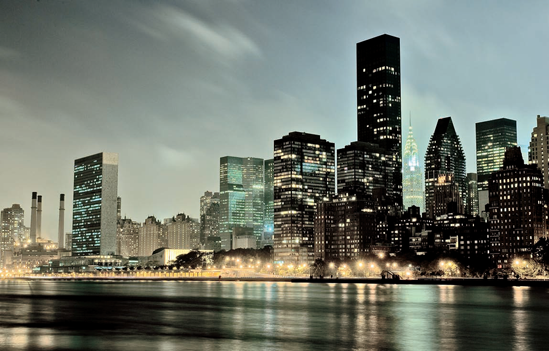
The beautiful colors of sunrise and sunset ensure that you get an image with a dramatically heightened mood By putting an opaque object in front of a bright background, you can render the foreground subject in silhouette, as this photographer has done Whenever possible, try to scout out a good location ahead of time and look for simple, recognizable shapes, like this dock, to silhouette against the sky It's important that the subject be surrounded by a bright background to be identifiable The colors of a sunrise can vary greatly from place to place, and even from minute to minute in the same place You'll want to shoot a lot of images and bracket exposures in the small window of time that's available Here, the bright colors are reflected nicely in the water, and the sun, just beginning to peek above the horizon, shows the promise of a new day.
"I love getting up early in the morning to take advantage of the light and color that a dramatic sunrise offers. While the same can be said for a setting sun, I feel that the light a morning sun provides is more dramatic, but also more fleeting. This shot was taken at 5:00 a.m. with the sun just peeking over the horizon. The lake reflected the morning colors, making the scene even more dramatic. This image was shot in RAW."
Canon EOS 20D digital SLR
Canon EF 16–35mm f/2.8L II zoom lens set at 32mm
1/400 of a second at f/8
ISO 800
Ambient light at daybreak
"Madison Sunrise"
© Todd Klassy
Belleville, Wisconsin http://flickr.com/photos/latitudes
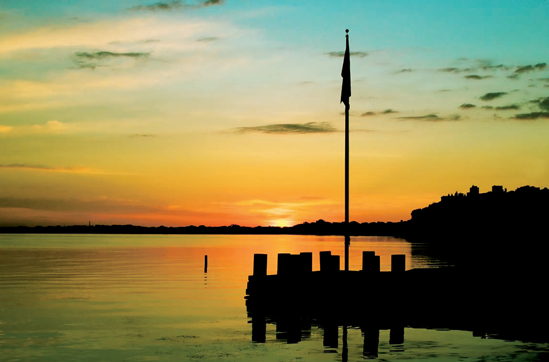
The photographer has heightened the excitement of this performance by deliberately not using flash, which would have minimized the impact of the fire this performer is using at night. She has also chosen to render it as blurred action, which accentuates the motion of this image. This photo presents a good reason to not limit your outdoor photography to daylight situations only. Pictures taken with existing light at night have an energy that isn't present during the daytime.
"I travel to Grand Junction, Colorado every year to visit my parents. While I'm there, I always do as much photography as possible. A couple of nights before I left, I went to a local street fair, not expecting anything out of the ordinary. But I was pleased to see that a group of fire dancers was scheduled to perform later that evening. This was total experimentation for me; I aimed the camera at them and kept shooting, playing with the shutter speed and moving around for different angles. To my surprise, I had several very good images. The unexpected can be a blessing in disguise."
Canon EOS 20D digital SLR
Canon EF 28–135mm f/3.5–5.6 IS zoom lens set at 135mm
1/8 of a second at f/5.6
ISO 400
Ambient light at night
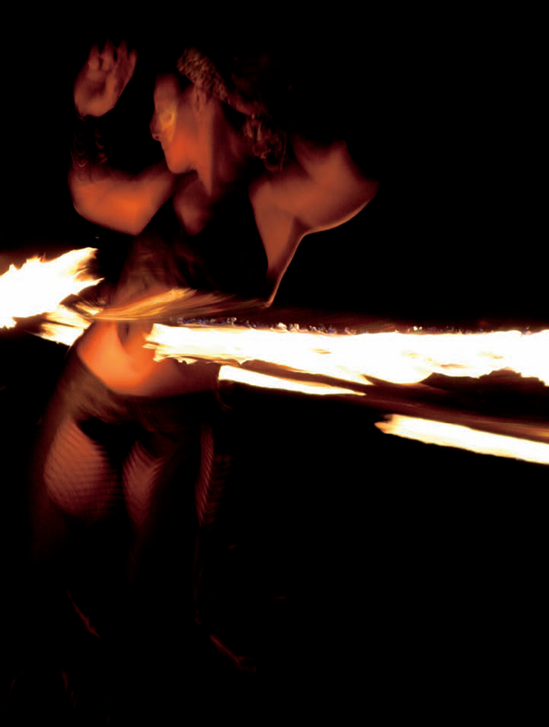
"Fire Dancer"
© Rhonda Mock
Walker, Louisiana
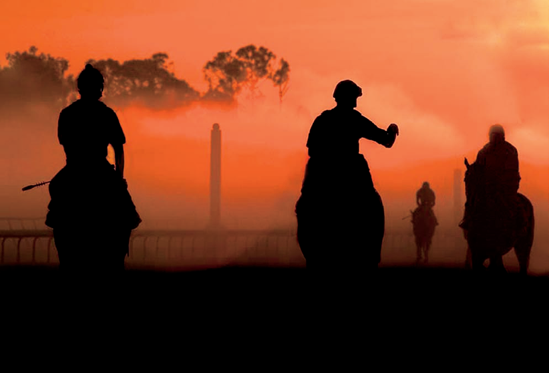
"Moonset: Ute Pass, Grand County, Colorado"
© A drew Scott Fulton
Centennial, Colorado http://afpfa.photoworkshop.com/
We associate nighttime with feelings like peacefulness and calm. This photo captures clouds illuminated by moonlight, which creates an aura of drama and mystery. A long exposure accentuates this nocturnal glow and reveals details that aren't apparent to the human eye at the time of shooting. To take pictures at night, you need to use a tripod to steady your camera during long exposure times. It's also a good idea to plan your shoot when the sky is relatively clear and the moon is full.
"My intention was to make a mural-sized panorama of the entire Gore Range, and I arrived at this location atop Ute Pass about 45 minutes before sunrise. After setting up my camera and tripod, I sat on the lift gate of my truck sipping coffee while trembling from the cold. I decided to jog back and forth a few times to keep my blood moving. As I did this, I looked over my shoulder to the left and saw that a bank of clouds had completely covered the moon, creating an incredibly surreal blue haze. I ran back to my camera and made three horizontal exposures. I wanted to ensure strong saturation in the sky, so I used my Pentax spot meter and metered its bluest part at 50 percent. I didn't realize what I had in this image until I got it into my computer."
Nikon D70s digital SLR
Nikkor 85mm f/1.4 lens
15 seconds at f/8
ISO 200
Moonlight
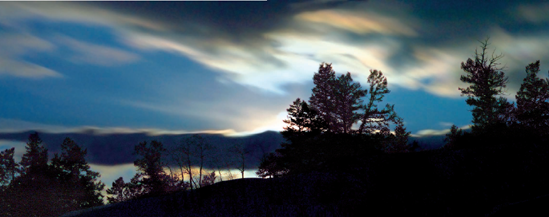
"Early Morning"
© Joel P. Black
Boynton Beach, Florida www.photosbyblack.com
The colorful sky at sunrise is beautiful on its own, but your images will be that much more intriguing if you include a well-placed silhouette or two in the foreground. Your subjects can be trees, a couple strolling on the beach, or even trainers on horseback, as this photographer has done. The mist creates a dreamlike effect, and adds greatly to the atmosphere of this scene.
"I shoot thoroughbred horse racing at Gulfstream Park in Hallandale Beach, Florida. As part of my assignments, I often shoot the training sessions of particular horses at Palm Meadows Thoroughbred Training Facility in Boynton Beach. I arrived prior to sunrise on this morning and waited while the first group of horses came out for their workout. It was still chilly, which created a mist on the grassy meadows that surround the track, while the sun was just coming up over the horizon and the sky was all aglow. I took a meter reading and determined the exposure of the bright sky because I wanted to silhouette the riders in the foreground. I wanted to shoot at a speed that would stop any action on the track, so I chose 1/800 and used the camera's tracking and burst capabilities to capture this image. I tried several different combinations of f-stops and shutter speeds to capture this scene, but in my opinion, this was the best one."
